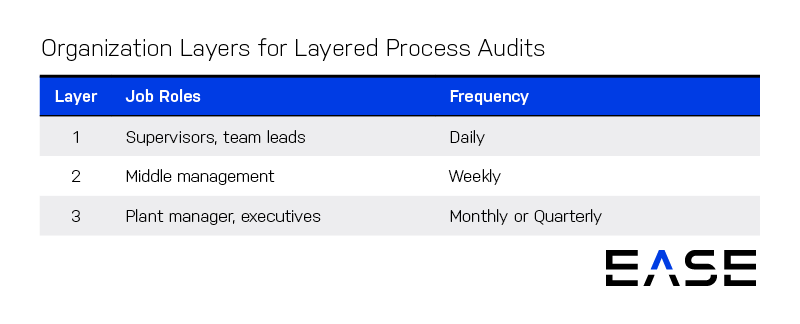Understanding New GM Layered Process Audit Requirements in IATF 16949


General Motors (GM) recently published updated customer specific requirements for IATF 16949 compliance. The new requirements take effect November 1, 2017 and covers layered process audit (LPA) requirements in greater depth than previous versions.
LPAs use a series of frequent audits to check high-risk processes and known problem areas. Big changes to GM’s LPA requirements focus on scheduling, organizational participation and performance improvement. Let’s examine the most important updates, and how automation makes compliance simpler. GM Layered Process Audit
Organization-Wide Engagement in Audits
GM’s new customer specific requirements are clear that LPAs must include top management, adding a new requirement for all departments in the organization to participate.
It’s an area where many organizations fall short, which is likely why GM is giving cross-functional engagement more attention. While getting buy-in can be hard, communicating the value of LPAs help get people on board and willing to contribute their time.
Benefits of drawing auditors from across the company include:
- Making quality part of everyone’s job description: If it’s only quality professionals conducting LPAs, you’re doing it wrong. A culture of quality requires everyone’s participation.
- Unlocking hidden insights and process issues: Non-experts often provide fresh observations that those close to the process don’t see. Having auditors from other work areas also reduces the risk of pencil-whipped results from employees rushing through audits.
- Visibly prioritizing quality: By definition, LPAs include all layers of personnel and therefore cannot be delegated. Management presence during audits provides critical coaching opportunities and authentic proof of your quality commitment.
Scheduling Layered Process Audits
Another notable change in GM’s customer specific requirements is that suppliers must maintain a defined LPA schedule. This audit schedule needs to outline the frequency of audits and specific locations for planned audits.
While the new GM requirements don’t specify LPA frequency, the typical schedule might look like the following:

Beyond just creating the schedule, you should also have a framework in place to ensure you stick to it. For example, how will you notify team members when an audit is due? What’s your escalation procedure if an employee does not complete a scheduled audit, or if they don’t complete it on time?
One common mistake with LPA programs we see is an inability of paper-based tracking methods to keep up with a high volume of audits, leading to:
- Low audit completion rates
- Problems with on-time auditing and corrective action closure
- Lack of effective reporting, another focus of the new GM requirements
Leveraging Process Audits for Performance Improvement
Several of GM’s customer specific requirements for LPAs focus on performance improvement, including:
- Customer complaints: Suppliers must show any rejections or complaints result in a layered audit on the process that caused the problem.
- Measurement and reporting: According to GM, “All findings are recorded and measured for improvement.” Basically, it’s not enough to simply produce a stack of checklists when GM audits your facility. You need evidence that you’re actually doing something with the results.
- Corrective action: Organizations must now use LPAs for corrective action verification. That means you can’t just use the same checklists over and over. Instead, you must constantly update LPA questions to reflect evolving risks and verify that you’re holding any gains.
Why LPA Automation = Happier Customers
The words “customer audit” are enough to raise the blood pressure of even a high-performing supplier. If you’re struggling with quality issues like high PPM, rejections and complaints, the stress is even worse.
However, our users report that even when OEMs are highly critical during audits, automated LPA systems make an overwhelmingly positive impression. That’s because LPA software addresses common process audit mistakes and demonstrates more robust, standardized procedures.
An automated platform simplifies audit management and compliance with GM’s new LPA requirements, including areas such as:
- Audit scheduling: Computerized scheduling lets you randomize who audits different areas, also tracking when and where audits happen.
- Cross-functional participation: LPA software simplifies scheduling for all levels of employees, sending out automated reminders, links to checklists and escalations as necessary. Keeping a record of participation facilitates greater accountability for results.
- Customer complaints: An effective LPA system will let you tag individual questions with the customer name and complaint number for easy tracking.
- Reporting and performance improvement: Effective reporting is nearly impossible with paper-based or spreadsheet-based systems. Automation makes reports instantly available, so you can pinpoint improvements faster.
- Corrective action: LPA software lets you easily add and randomize questions for corrective action verification, instead of having to reissue paper checklists.
Looking at GM’s new customer specific requirements, it’s obvious that the company is trying to move suppliers beyond a “check the box” mentality. Addressing the details takes work, but done correctly will result in an LPA program that actually achieves its true purpose.